Ankarana National Park
The Ankarana National Park is located in the Diana region in the northern part of Madagascar. The park lies 108 kilometres south of Antsiranana (Diego Suarez) and about 20 kilometres north of Ambilobe. The four rural disctricts of Marivorahona, Anivorano, Ambondrona and Antsaravibe surround the park. From Antsiranana it takes between two and three hours by taxi-brousse to reach the main entrance on the east-side at Mahamasina along the RN6. Most of the people living in the region belong to the Antakarana ethnic group.
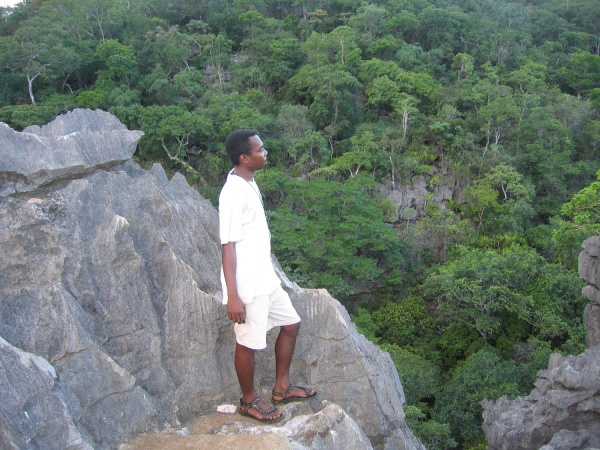
| ||
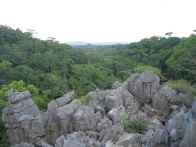
|
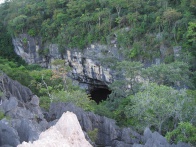
|
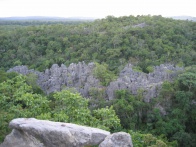
|
Ankarana National Park was founded in 1956. The park has a total area of 18,225ha and an altitude of 206m. The predominant climate is dry tropical with an annual rainfall below 2,000mm. Most of the rain falls in January. The dry season lasts from April to November. March is the hottest month with a maximum temperature of 36.2°C and June is the coldest with a minimum temperature of 13.5°C.
The topography of Ankarana is characterised by limestone emerging from a basaltic plain 50m above sea level, forming the tsingy (sharp limestone karst pinnacles). Numerous underground caves and canyons traverse the massif. Four major rivers flow through the reserve: Besaboba eastward, Ankarana from the north, Antenan'Ankarana and Mananjeba from the south. The first three are underground rivers whose specific watercourses still remain unknown.
Contents
- 1 Fauna
- 2 Invertebrates
- 3 Vertebrates
- 4 The best fauna most visible to tourists
- 5 Flora
- 6 The best flora most visible to tourists
- 7 Guides and entrance fees
- 8 Circuits (tours) in the eastern part of the park
- 9 The Turrets of the Tsingy =
- 10 Circuits (tours) in the western part of the park
- 11 Fady - What not to do in the park
- 12 Accommodation in the park
- 13 Accommodation outside the park
- 14 Additional information
Fauna
For visitors of the reserve there is much to discover in the forest, rivers and caves. In 2010 a biological inventory identified:
- 50 shellfish species and a large number of tsingy snails
- 14 bat species, half the species of bats in Madagascar
- 60 species of reptiles and amphibians
- 11 species of lemurs
- 96 bird species
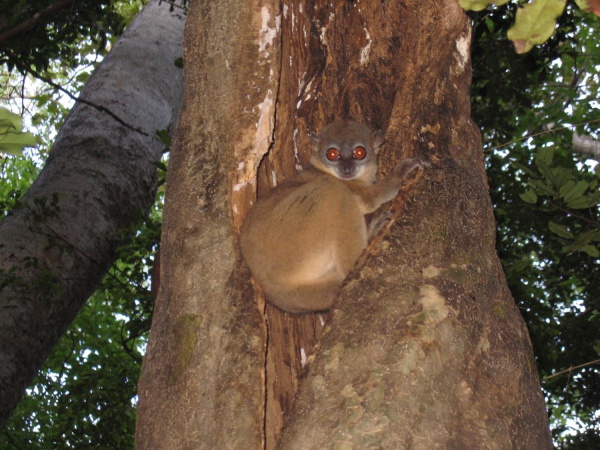
| ||
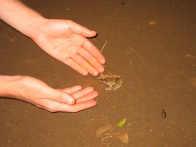
|
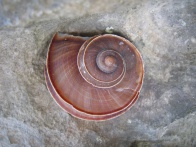
|
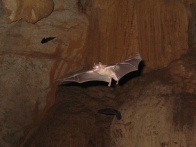
|
Invertebrates
Ankarana is home to at least 50 shellfish species, including 10 water species. Amongst the most interesting species is the great land snail Tropidophora. Several species of collembola (springtail) and amphipods are endemic to the caves and streams of Ankarana.
Vertebrates
Fishes
The species Glossogobius ankaranensis is endemic to Ankarana. Glossogobius callidus (River goby) and Pachypanchax sp are also present in the streams of Ankarana.
Reptiles / Amphibians
Ankarana has a very high diversity of reptiles and amphibians, at least 60 species have been inventoried. Following species are endemic to Ankarana:
- Frogs
- Anodonthyla sp nov
- Mantidactylus sp nov
- Skink
- Amphiglossus sp nov
- Snakes
- Alluaudina moquardi
- Liophidium therezieni
- Liophidium sp nov
- Heteroliodon sp nov
- Stenophis sp nov 1
- Stenophis sp nov 2
- Lizard
- Lygodactylus expectatus
- Gecko
- Uroplatus ebenaui - Spear-tailed gecko (endemic to the far north)
- Crocodile
- Crocodylus niloticus - Nile crocodile
- Crocodylus niloticus - Nile crocodile
Birds
There are at least 96 bird species in Ankarana, many of which are of great importance for conservation. They are:
- Mesitornis variegatus - White-breasted mesite
- Tyto soumagnei - Madagascar red owl
- Ardea humbloti - Madagascar heron
- Ardeola idae - Madagascar pond-heron
- Lophotibis cristata - Madagascar crested ibis
- Haliaetus vociferoides or Haliaeetus vocifer - Madagascar fish eagle
- Aviceda madagascariensis - Madagascar cuckoo-hawk
- Accipiter madagascariensis - Madagascar sparrowhawk
- Caprimulgus enarratus - Collared nightjar
Mammals
Ankarana is home to many species of mammals, including 14 species of bats, meaning that half of the bats of Madagascar live in the underground caves of Ankarana. Two amongst them are the smallest and biggest bats of the world: The Megachiroptere (Megabat) and the Microchiroptere (Microbat).
Of the 11 lemur species present in Ankarana, the most commonly observed are:
- Eulemur coronatus - Crowned lemur
- Eulemur fulvus sanfordi - Brown lemur, sub-species Sanford's lemur
- Hapalemur griseus occidentalis - Bamboo lemur
- Lepilemur septentrionalis - Northern sportive lemur
- Phaner furcifer electromontis - Fork-marked lemur
- Daubentonia madagascariensis - Aye-aye
- Avahi occidentalis - Woolly lemur
- Microcebus tavaratra - Northern rufous mouse lemur - endemic
- Eliurus sp nov - Tufted-tailed rat - endemic
The famous Propithecus diadema perrieri, known as Black sifaka / Diademed sifaka, was last seen by park rangers in 1995 and 1996. Meanwhile, the presence of Microcebus myoxinus (Peters' mouse lemur) still needs to be to reconfirmed.
Endemic carnivores living in Ankarana are:
- Cryptoprocta ferox - Fossa
- Galidia elegans - Ring-tailed mongoose
- Fossa Fossana - Malagasy civet
The best fauna most visible to tourists
| Scientific name | English name | Description | Where to find | When to find |
| Eulemur coronatus | Crowned lemur | Crowned head lemur, male has a dark brown fur. | Prowls in the forest of the canyon near the camp and along the track to the Green Lake (Lac Vert). | Morning before noon and in the afternoon between 3pm and 5pm. |
| Eulemur fulvus sanfordi | Brown lemur / Sanford's lemur | More luxuriant hair on the head. Males have a bushy collar of beard. | On the Green Lake track and around the camp Andrafiabe. | Morning before noon and in the afternoon between 3pm and 5pm. |
| Lepilemur septentrionalis | Northern sportive lemur | Small lemur with big eyes. | Usually in a tree along the trail to the Green Lake and to the bats cave. | All day whilst sleeping. |
| Galidia elegans | Ring-tailed mongoose | Mongoose with deep reddish-brown fur and a long, bushy black and red striped tail. | Around the camp. | At any time of the day. |
| Uroplatus ebenaui | Spear-tailed gecko | Usually camouflaged in the colour of the tree trunk, sitting 1.50m above the ground. | On the slopes of the circuits but difficult to find because of its very effective camouflage. | During the morning. |
| Furcifer pardalis | Panther chameleon | Dark green chameleon with a red stripe, white on the stomach. | On the slopes of the circuits in the canyons, abundant in the rainy season. | At any time of the day. |
| Crocodylus niloticus | Nile crocodile | Black crocodile with short muzzle. Entire body lies in water, except the eyes and nose. | In the crocodile cave. | During the dry season at any time of the day. |
| Lophotibis cristata | Madagascar crested ibis | Bird with a bent stature, red and white feathers and short tail. | Along the trail to the Green Lake and in the canyon forest. | During the morning. |
| Mesitornis variegata | White-breasted mesite | A bird slightly larger than the green pigeons. Light brown mottled with white chest, pointed beak, often in groups of eight to ten. | Along the trail to the Green Lake and in the canyon forest. | During the morning and late afternoon. |
| Rousettus madagascarensis | Bats of larger size compared to other species, more elongated snout, gray/dark brown. | In several caves in Ankarana, several groups in the bats cave. | During the day. | |
| Glossogobius ankaranensis | Blind fish, white and transparent. | In the underground rivers in the caves. | During the day. |

| ||
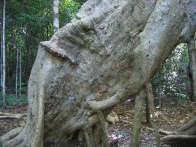
|
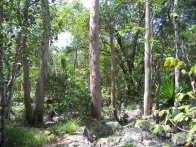
|
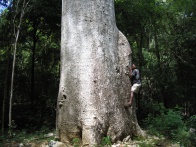
|
Flora
Studies have revealed, that at least 330 species plant species of 77 families grow in Ankarana. Most trees are deciduous and many bloom from September to November.
Several species endemic to the far north can be found in Ankarana:
- Pachypodium baronia - Madagascar palm
- Adansonia perrieri- Perrier's Baobab
- Delonyx velutina
- Hildegardia erythosyphon
In Ankarana also grow epiphytical plants, plants which grow on top of other plants and trees for mechanical support, but not for nutrients. The most remarkable is:
- Platicerium madagascariensis - Staghorn fern
Canopy species of Ankarana are:
- Dalbergia
- Canarium
- Sideroxylon
- Adenia
- Diospyros
- Pandanus
- Zanthoxylum
- Ficus
- Mezonovium
- Ricinus communis
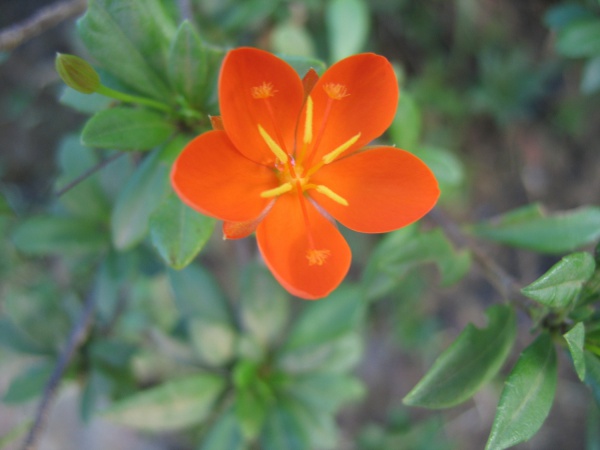
| ||
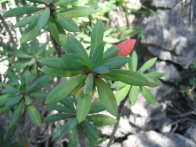
|
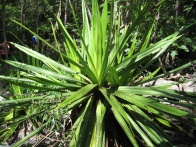
|
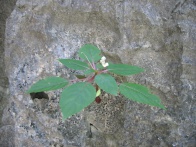
|
The vegetation of Ankarana is distinguished in:
- xerophytic vegetation on the tsingy with extreme adaptation to drought and forming a sparse coverage. The most typical species are:
- Adenia (Passifloraceae)
- Pachipodium
- Ficus (Moraceae)
- Euphorbia (Euphorbiaceae)
- Aloe (Liliaceae)
- forests on basaltic soils or in the gorges are the richest in species diversity. The most typical species are:
- Zanthoxylon (Rutaceae)
- Ficus (Moraceae)
- Dalbergia (Fabaceae)
- Cassia (Fabaceae)
- Diospyros (Ebenaceae))
- Canarium (Burseraceae)
- Andansonia (Bombacaceae)
- Pandanus (Pandanaceae)
- forests on calcareous soils or limestone and basalt mixture or deciduous forests and dry deciduous western forests
- wooded grassland, an are quite important for Commiphora (Burseraceae), Hildegardia (Sterculiaceae) and Andasonia (Bombacaceae). Canopy rising to 20 metres. This is the kind of forest known in western Madagascar.
- bamboo forests
- wetland vegetation which can be found near or around lakes or seasonal perennial.
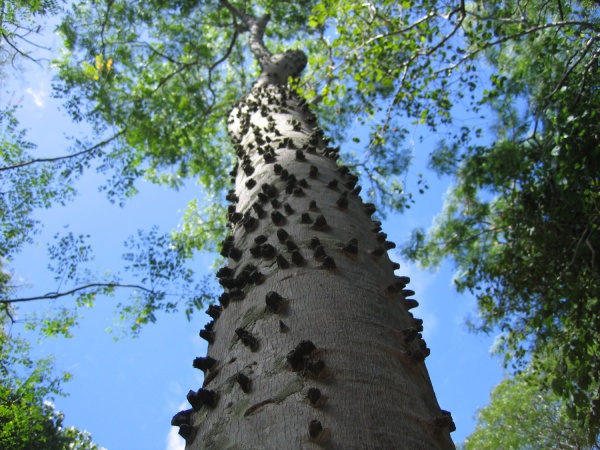
| ||
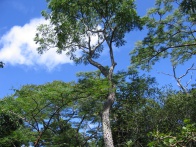
|
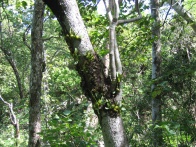
|
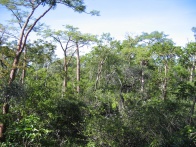
|
The best flora most visible to tourists
| Scientific name | English name | Description | Where to find |
| Adansonia madagascarensis | Baobab | Baobab with a large trunk and thick bark, high canopy. Edible fruits are rich in calcium. | Dominates the track of the Turrets of Tsingy. |
| Euphorbia ankaranensis | Tsingy vegetation, rough grass with spiny trunk and red flowers. Endemic to the reserve. | Grows between the rocks of the tsingy. | |
| Adenia lapiazicola | Tsingy vegetation, liana similar to the shape of a demijohn, stores water in the dry season. | Grows between the rocks of the tsingy. | |
| Cyphostema macrocarpa | Tsingy vegetation, bottle-shaped vine with bark that peels. | Grows between the rocks of the tsingy. | |
| Commiphora spp | Paper tree or Vazaha tree | Tree with a gnarled trunk, bark peels in the dry season. | In the tsingy and dense dry forest. |
| Dalbergia spp | Palissandre | Tree with a huge trunk and hard bark, high canopy. Leafs rather small and composed. | In the semi-evergreen forest of the canyon (along the trail to the Green Lake and near the Camp of the Princes. |
| Ficus spp | Tree with a huge trunk and air roots. | In the semi-evergreen forests of the canyon along the Green Lake trail. | |
| Tacca ankaranensis | Shrub with a long thin stem and leafs similar to a papaya. | Grows everywhere in the tsingy during the rainy season. |
Guides and entrance fees
There are 50 guides working at the park, all with excellent knowledge about the park, its biodiversity and ecosystems, ethical guidance, culture of the Antakarana people as well as first aid.
The admission fee for visiting the park for foreign tourists is 65,000 Ariary per day, children pay 25,000 Ariary per day (prices 2015). Half of the entrance fees goes to Madagascar National Parks and half to local communities. Guides are obligatory. The fee for a guide depends on the chosen tour (circuit).

| ||
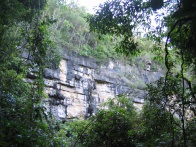
|
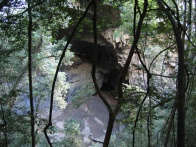
|
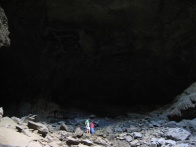
|
Circuits (tours) in the eastern part of the park
Eight circuits cross the eastern part of the Ankarana National Park. The starting point for all circuits is the main office at Mahamasina. It is possible to combine several circuits at one visit.
The Cave of the Bats
Easy 2 to 3 hours trek, including a steep slope, to an underground cave with 8 species of bats from small to large size. It is possible to see some lemurs such as the Crowned lemur, Sanford's lemur and Northern sportive lemur. If lucky, one can see a Ring-tailed mongoose and even a Fossa.
Guide: 25,000 Ariary, park warden: 20,000 Ariary, porter: 10,000 Ariary (prices 2010)
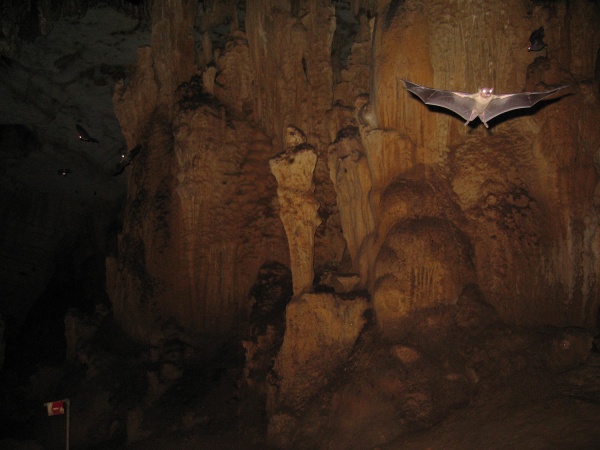
| ||
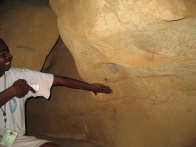
|
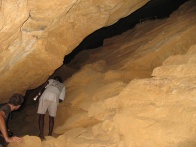
|
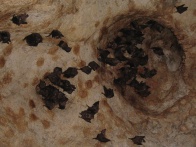
|
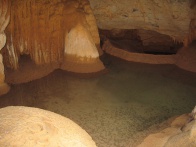
|
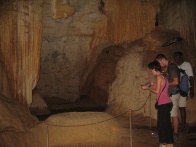
|
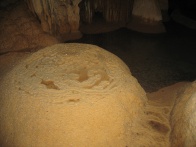
|
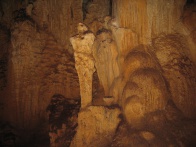
|
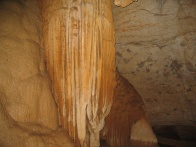
|

|
Lost Rivers
Easy 1 to 2 hours trek, suitable for combining one-way with other circuits. Great views over the Ankarana landscape from the Ampasambazaha viewpoint. The track crosses a baobab forest, very close to the Ampondrabe river. The circuit ends at a big gulf (lost rivers) where the three Ankarana rivers flow away (especially spectacular after lots of rain). Along the track it is possible to observe animals such as Brookesia (Leaf chameleon), Crowned lemur, Sanford's lemur and Northern sportive lemur as well as birds such as the rare Dronge and Magpie-robin.
Guide: 25,000 Ariary, park warden: 20,000 Ariary, porter: 10,000 Ariary (prices 2010)
Tsingy Meva
Easy 2 to 3 hours trek with a steep climb and steep descent. The track passes through the northern Ankarana massif and the southern part of the Montagne d’Ambre. Along the track it is possible to see the entrance of the bats grotto. Trekkers have the opportunity to touch the tsingy and observe its particular vegetation, such as the endemic Pachypodium decaryi, Cyphostemma and
Euphorbia ankaranensis. Lemurs include the Crowned lemur, Sanford's lemur and Northern sportive lemur. Furthermore, one can see the Ring-tailed mongoose, skinks (in the rainy season), Velvet gecko, Leaf chameleon and Flat-tailed gecko.
Guide: 25,000 Ariary, park warden: 20,000 Ariary, porter: 10,000 Ariary (prices 2010)
The Turrets of the Tsingy =
3 to 4 hours walk, suitable for combining one-way with other circuits. The trek is easy, but the crossing of a small river is required in the rainy season. The track leads through the tsingy in the shape of turrets. A walk through crevasses gives the possibility to learn more about the typical vegetation of the tsingy. A large baobab tree with over 8m in perimeter is an ideal location for a break. Throughout the track one can see the Northern sportive lemur, the rare bird Crested coua and reptiles such as skinks (in the rainy season) and the Leaf chameleon.
Guide: 25,000 Ariary, park warden: 20,000 Ariary, porter: 10,000 Ariary (prices 2010)
Tsingy Rary
3 to 4 hours walk, suitable for combining one-way with other circuits. The trek is easy, but the crossing of a small river is required in the rainy season. This circuit shows the picturesque landscape of the tsingy, the duality between limestone and volcanic rocks and the particular vegetation that grows there. Crowned lemur, Sanford's lemur, Northern sportive lemur, Madagascar crested ibis, White-breasted mesite and skinks (in the rainy season) can be seen.
Guide: 25,000 Ariary, park warden: 20,000 Ariary, porter: 10,000 Ariary (prices 2010)
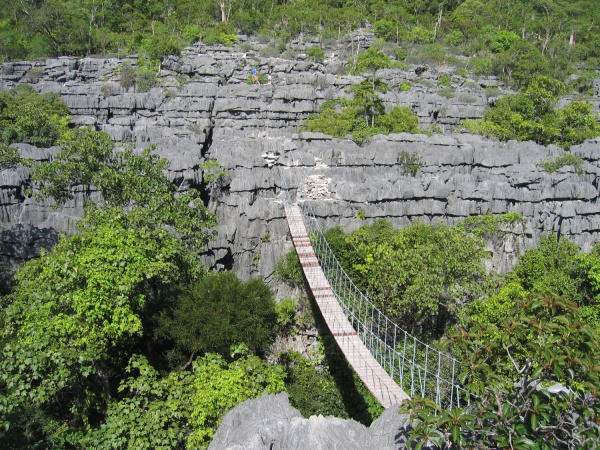
| ||
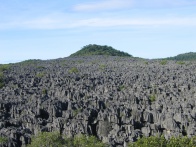
|
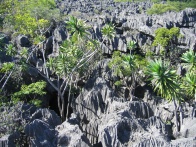
|
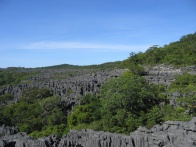
|
7 hours trek, moderately difficult because the track is mostly walking on the tsingy. This circuit is ideal to enjoy the wonderful landscape of the tsingy and its particular vegetation. The Benavony underground cave (250 metres) has very beautiful dripstone formations. Trekkers can see the amazing landscape from above on suspension bridges, which join two small canyons. Animals living in the area include the Crowned lemur, Sanford's lemur, Northern sportive lemur, Ring-tailed mongoose and fossa. The vegetation of the canyon is dominated by Moraceae (Ficus).
Guide: 40,000 Ariary, park warden: 30,000 Ariary, porter: 15,000 Ariary (prices 2010)
The Viewpoint of Ambohimalaza
4 to 5 hours trek, easy but steep in the final stretch. The track leads through a forest of the endemic tree "Taim-papango" and through the forest of big lianas and ficus. At the viewpoint a postcard picture surprises with views of Ambilobe in the west, over the tsingy and the Mozambique Channel spotted with islets (Nosy-Be, Mitsio etc.) at the horizon. From the highest point of the plateau one can see the whole northern part of the Ankarana National Park, which is dominated by the silhouette of Montagne d'Ambre. Along the track one may spot Crowned lemur, Sanford's lemur, Northern sportive lemur, Spear-tailed gecko and birds such as Madagascar harrier-hawk, Peregrine falcon and Guinea fowl.
Guide: 25,000 Ariary, park warden: 20,000 Ariary, porter: 10,000 Ariary (prices 2010)
Lac Vert / The Green Lake
8 to 9 hours trek, moderately difficult because of the length of the trail. This part of Ankarana is only accessible during the dry season from June to December. The track comprises the extent of the tsingy. The Amposatelo stream is ideal for a cool-down and swim. Trekkers can observe Crowned lemur, Sanford's lemur, Northern sportive lemur, Ring-tailed mongoose, fossa, birds such as a White-breasted mesite, Madagascar crested ibis and flycatcher.
Guide: 40,000 Ariary, park warden: 30,000 Ariary, porter: 15,000 Ariary (prices 2010)
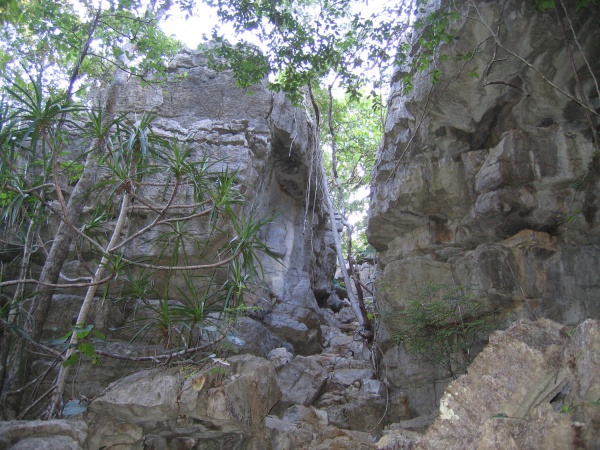
| ||
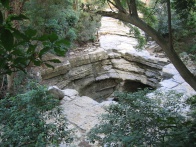
|
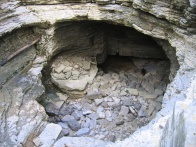
|
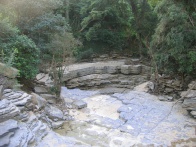
|
Circuits (tours) in the western part of the park
The western part of Ankarana is only accessible during the dry season from June to December, when the Antenan'Ankarana river can be crossed by car. This park area is dominated by caves. The caves form either long galleries or are sheltered by large and long, 50 to 60 metres high tsingy walls. This tsingy wall, interspersed with canyons, is the natural boundary of the western park, known as the "Wall of Ankarana".
The Cave and Cathedral of Andrafiabe
A moderately difficult 5 hours walk. The underground cave of Andrafiabe as well as the cathedral of Andrafiabe both have beautiful dripstone formations. Both the cave and the cathedral are confined by huge rocks. An opening in the ceiling of the cathedral lets the sun shine through, creating a halo of light. The canyon of the small hills of Chaumont, which connects the two underground caves, is a magnificent valley. 11 species of bats (including the smallest and the largest), Sanford's lemur, Crowned lemur, birds (e.g. flycatcher) and reptiles (Spear-tailed gecko) can be seen along this track.
Guide: 40,000 Ariary, park warden: 30,000 Ariary, porter: 15,000 Ariary (prices 2010)
Skeleton Cave and 2nd Canyon
A 2 to 3 hours moderately difficult trek. The skeleton of an Antakarana warrior who died of hunger during the tribal war was found in this cave. The cave has beautiful dripstones and the vegetation in the canyon is quite impressive. Fruit trees such as "wild orange" and the non-edible "wild cassava" dominate the track. Crowned lemurs, Sanford's lemurs, birds such as the Vasa parrot, flycatcher and Guinea fowl, geckos and lizards can be observed throughout the trek.
Guide: 35,000 Ariary, park warden: 25,000 Ariary, porter: 10,000 Ariary (prices 2010)
Milaintety Cave and Potamochère Cave
A 3 to 4 hours trek, sometimes moderately difficult. The track leads to a cave with impressive dripstone formations. At the exit of the cave is a natural water basin with islets of ferns, which are absolutely worth seeing. The cave is home to three small bat species, such as the Malagasy mouse-eared bat (Myotis goudoti), Glen's long-fingered bat (Miniopterus gleni) and the Manavi long-fingered bat (Miniopterus manavi). More fearful residents of the cave are the Nile crocodiles. At the entrance of the cave Moraceaes (Ficus) grow whilst at the exit reeds and ferns grow. Whilst trekking one may see snakes, Crowned lemurs and Guinea fowls.
Guide: 35,000 Ariary, park warden: 25,000 Ariary, porter: 10,000 Ariary (prices 2010)
The Green River and 1st Canyon
A moderately difficult 4 to 5 hours walk. The Green River is a mysterious underground river. Its emerald green waters crosses the canyon briefly before disappearing again into the rock. There is a possibility to spot Sanford's lemur, Crowned Lemur, Northern sportive lemur, Northern rufous mouse lemur and even the nocturnal Aye-aye in the canyon. Carnivores include the Ring-tailed mongoose, Fossa and Malagasy civet.
Guide: 40,000 Ariary, park warden: 30,000 Ariary, porter: 15,000 Ariary (prices 2010)
Antsironandoha Cave
A moderately difficult 3 to 4 hours trek. The underground cave has beautiful dripstone formations. On the outer walls at the entrance of the cave are parrot nest by a forest with several types of Moraceae (Ficus). 6 species of bats from the smallest to the largest can be observed: Madagascan fruit bat, Madagascan rousette, Madagascar free-tailed bat, Malagasy mouse-eared bat, Glen's long-fingered bat and the Manavi long-fingered bat. Birds along the track include Vasa parrot and the Guinea fowl.
Guide: 35,000 Ariary, park warden: 25,000 Ariary, porter: 10,000 Ariary (prices 2010)
The Crocodiles Cave and Lake Ampandriamborona
A 5 to 6 hours walk of moderate difficulty. This track leads to an underground cave with dripstone formations and a dark river with Nile crocodiles. The perennial lake is a good spot to watch water birds, such as Humblot's heron and Madagascan pond heron. The entrance of the cave is framed by Moraceae (Ficus) of which several types grow along the underground river that flows out of the cave. At the exit of the cave there is a vegetation rich swamp. Beside the crocodiles, the endemic blind fish (Glossogobius ankaranensis) is the main attraction of this trek.
Guide: 35,000 Ariary, park warden: 25,000 Ariary, porter: 10,000 Ariary (prices 2010)
The Cave of the Pigeons and Lake Mangily
A 4 to 5 hours moderately difficult trek to a cave with dripstone formations and an underground river. The perennial lake is home to water birds, such as Humblot's heron and Madagascan pond heron. The endemic blind fish (Glossogobius ankaranensis) and Nile crocodile are the highlights of this walk. At the entrance of the cave grows marsh vegetation (reed) and a forest of Moraceae (Ficus).
Guide: 35,000 Ariary, park warden: 25,000 Ariary, porter: 10,000 Ariary (prices 2010)
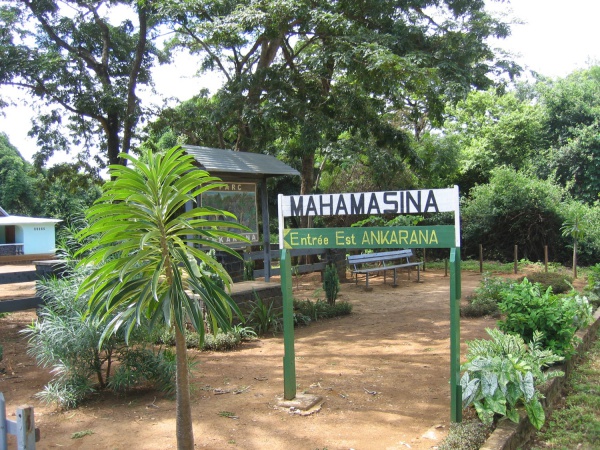 |
Fady - What not to do in the park
As many other ethnic groups in Madagascar, also the Antankarana people follow customs and traditions. Fady's are not strictly taboos, they are more beliefs which signal when something is "dangerous" related to action, food, locations etc. The following fady's in the Ankarana National Park apply both to locals and visitors.
Fady in the park:
- To bring "ravinala" (Traveller's Tree) and "antomby" or "garaba" (poultry cages) into the park.
- To bring "voanjobory" (Bambara groundnut), pork or wild boar meat into the park.
- Relief oneself in undesignated areas.
Fady in the caves:
- Access to the caves is forbidden for descendants of the lines who fought the Antankarana Kingdom (including Merina people and Antankarana traitors).
Strictly forbidden:
- Sex
- Access is prohibited to women in menstruation.
Tips:
- Nothing should be brought into or taken out of the caves.
- It is not allowed to remove bones, artifacts or living cave formations.
- Visit the caves bareheaded (without a hat) in respect of the Antankarana ancestors.
- Do not relief yourself inside the cave.
Some of the caves in Ankarana are sacred sites, such as the Cave of Kings, which is the tomb of the Antankarana kings.
Accommodation in the park
Campement des Princess: Located on basaltic soil in the forest (East Ankarana). 22 tents for 44 people, 3,000 Ariary per person/night.
Campement d’Amposatelo: Located on basaltic soil in the forest and along a stream (in the heart of the park). 5 tents for 10 people, 3,000 Ariary per person/night.
Campement d'Andrafiabe: Located in the bushland at the foot of the tsingy cliff (West Ankarana). 42 tents for 84 people, without shelter 3,000 Ariary per person/night, with shelter 5,000 Ariary per person/night.
Campement d’Anilotra: Located on basaltic soil in the forest (West Ankarana). 5 tents for 10 people, 3,000 Ariary per person/night.
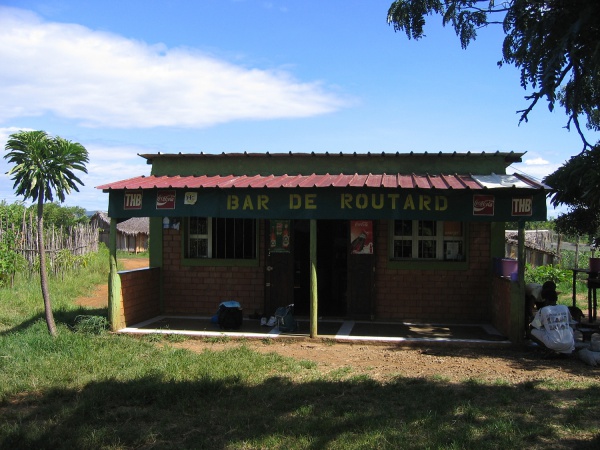
| ||
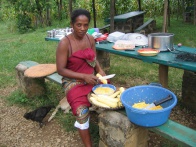
|
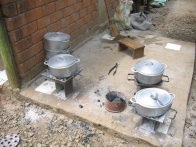
|
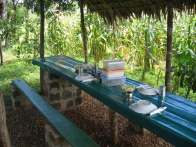
|
Accommodation outside the park
Around the park there are several accommodation possibilities, reaching from basic bungalows to comfortable hotel rooms.
Chez Goulam (12 bungalows)
Mahamasina
Tel: +261 (0)32 5268282 (mobile) or +261 (0)32 0269106 (mobile)
Email: goulamguide_ds@yahoo.fr
Chez Aurelien (18 bungalows and camping)
Mahamasina
Tel: +261 (0)32 0278600 (mobile) or +261 (0)32 4063014 (mobile)
Email: aurelien_ank@yahoo.fr
Tsingy Relais or Chez Robert (17 rooms)
Ambatomitsangana
Tel: +261 (0)20 8206565
Ankarana Lodge (5 bungalows, guest house with several rooms, 5 pavilions with tents)
Tel: +261 (0)32 0490810 (mobile)
Email: info@ankarana-lodge.com
www.ankarana-lodge.com
Relais de l'Ankarana (6 bungalows)
Mahamasina
Tel: +261 (0)32 0222294 (mobile)
Email: ankarana.lerelais@gmail.com
www.relaisdelankarana.unblog.fr
Additional information
- View all Ankarana National Park photos
- Madagascar National Parks - Plentiful information about the National Parks in Madagascar in English, French, German and Italian - Note May 2016: The Madagascar National Parks website is updated and content is available only in French.